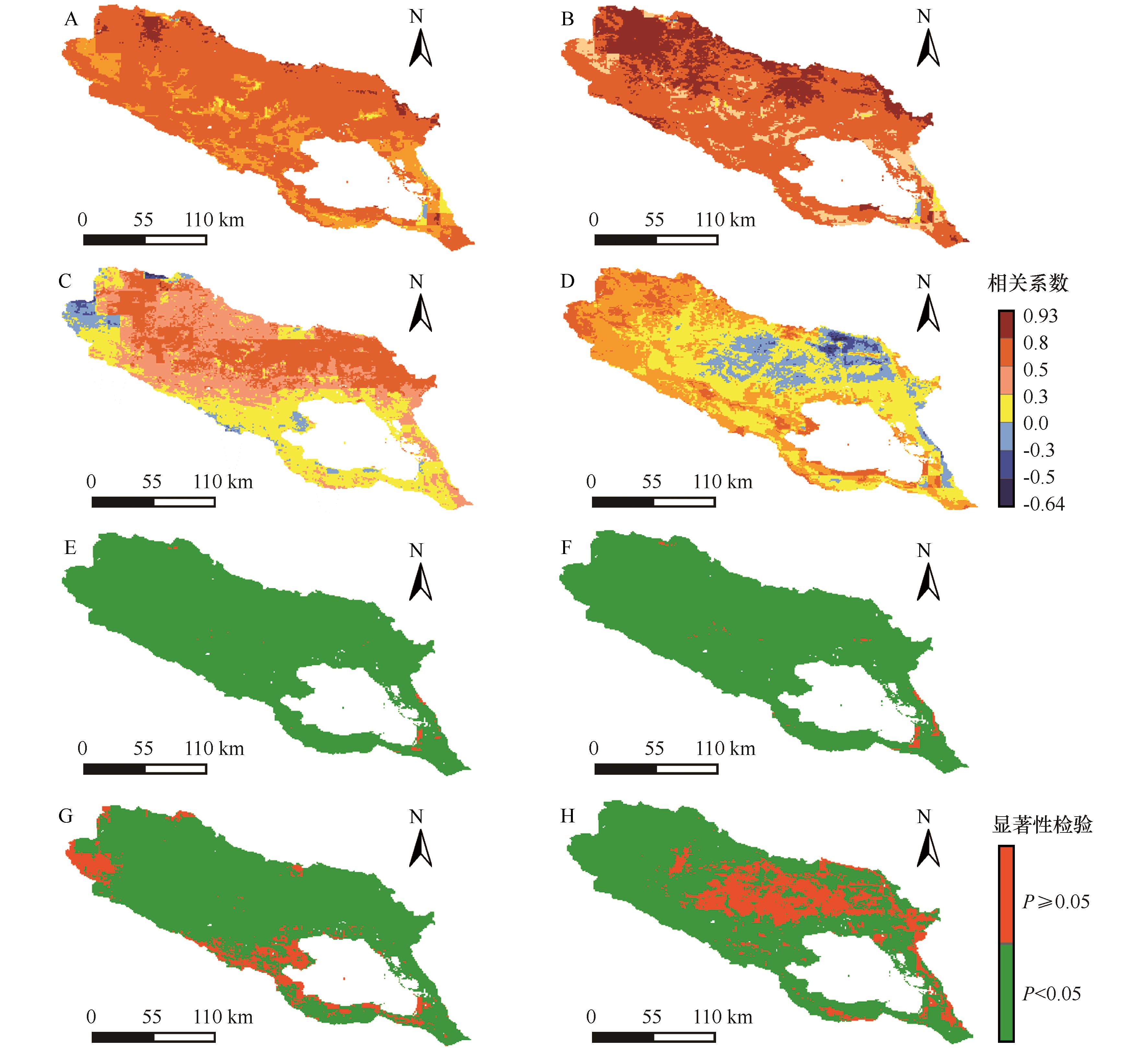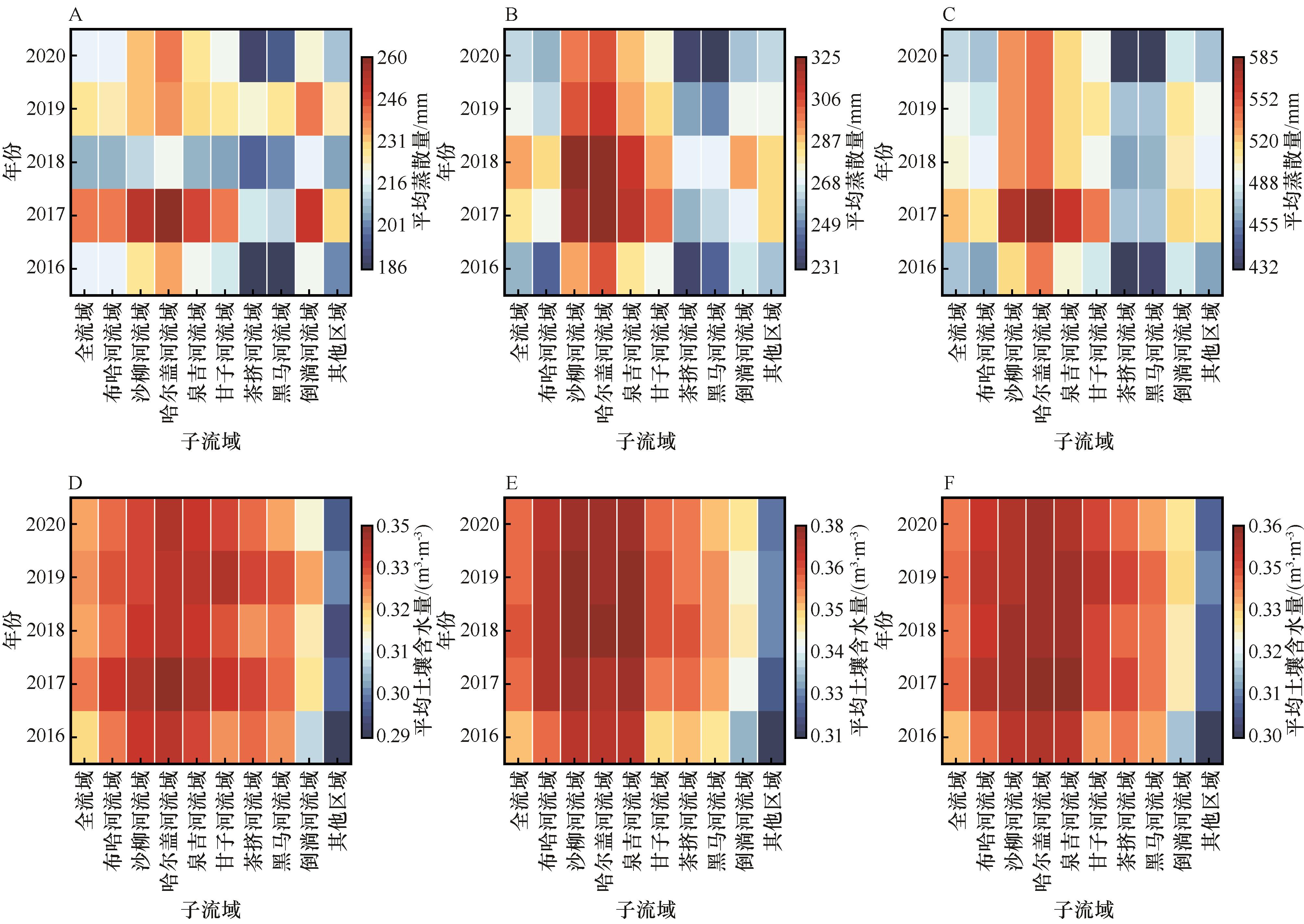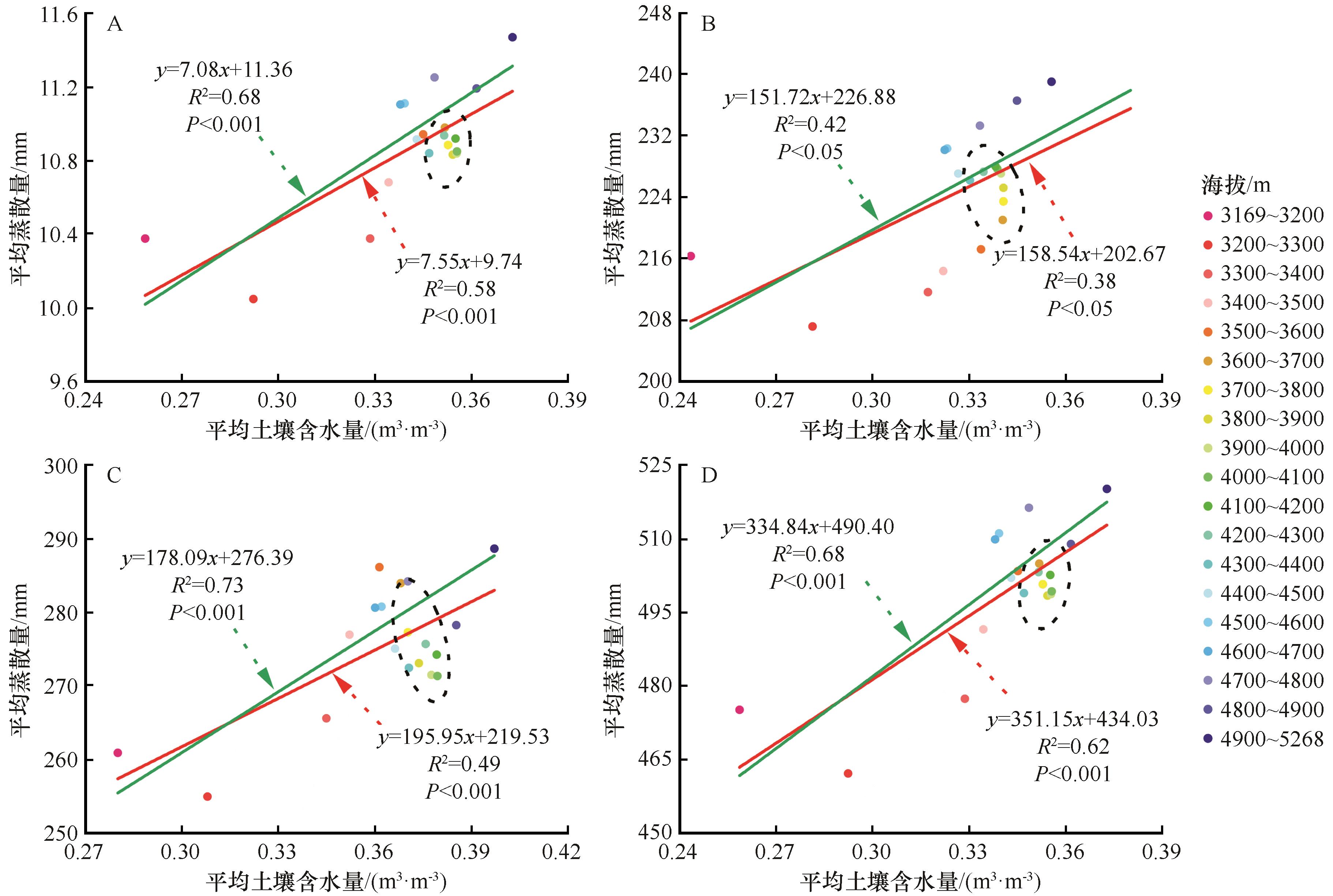
- CN 62-1070/P
- ISSN 1000-694X
- Bimonthly 1981

Journal of Desert Research ›› 2024, Vol. 44 ›› Issue (3): 202-212.DOI: 10.7522/j.issn.1000-694X.2024.00038
Lianxuan Chen1( ), Shengkui Cao1,2(
), Shengkui Cao1,2( ), Guangchao Cao1,2, Yizhen Lei1, Haoran Zhao1, Wenbin Li1
), Guangchao Cao1,2, Yizhen Lei1, Haoran Zhao1, Wenbin Li1
Received:2024-01-30
Revised:2024-03-03
Online:2024-05-20
Published:2024-06-11
Contact:
Shengkui Cao
CLC Number:
Lianxuan Chen, Shengkui Cao, Guangchao Cao, Yizhen Lei, Haoran Zhao, Wenbin Li. Temporal and spatial response characteristics of evapotranspiration to soil water content in Qinghai Lake Basin[J]. Journal of Desert Research, 2024, 44(3): 202-212.
Add to citation manager EndNote|Ris|BibTeX
URL: http://www.desert.ac.cn/EN/10.7522/j.issn.1000-694X.2024.00038

Fig.5 Spatial distribution of average evapotranspiration and average soil water content during the non-growing (A, C) and growing (B, D) seasons in Qinghai Lake Basin from 2016 to 2020
| 指标 | 年份 | ||||
|---|---|---|---|---|---|
| 2016 | 2017 | 2018 | 2019 | 2020 | |
| 蒸散量/mm | 471.77 | 522.57 | 498.58 | 497.41 | 481.91 |
| 土壤含水量/(m3·m-3) | 0.34 | 0.34 | 0.34 | 0.34 | 0.34 |
Table 1 Temporal variations of annual evapotranspiration and soil water content in Qinghai Lake Basin from 2016 to 2020
| 指标 | 年份 | ||||
|---|---|---|---|---|---|
| 2016 | 2017 | 2018 | 2019 | 2020 | |
| 蒸散量/mm | 471.77 | 522.57 | 498.58 | 497.41 | 481.91 |
| 土壤含水量/(m3·m-3) | 0.34 | 0.34 | 0.34 | 0.34 | 0.34 |

Fig.8 Spatial distribution of correlation coefficients and significance test between evapotranspiration and soil water content at 8-day (A,E), monthly (B,F), non-growing season (C,G) and growing season (D,H) scale in Qinghai Lake Basin

Fig.9 Heatmaps of non-growing season (A,D), growing season (B,E) and annual (C,F) average evapotranspiration and average soil water content in sub-basins of Qinghai Lake Basin

Fig.11 Evapotranspiration and soil water content at different altitudes at 8-day (A), non-growing season (B), growing season (C) and annual scale (D) in Qinghai Lake Basin
| 1 | 郭林茂,常娟,周剑,等.唐古拉地区活动层水热状况及地气系统能水平衡分析[J].高原气象,2020,39(2):254-265. |
| 2 | 邴龙飞,苏红波,邵全琴,等.近30年来中国陆地蒸散量和土壤水分变化特征分析[J].地球信息科学学报,2012,14(1):1-13. |
| 3 | 潘兴瑶,夏军,张橹.土壤水分随机模型支持下的土壤水平衡研究进展[J].资源科学,2008,30(3):460-467. |
| 4 | 杨胜天,刘昌明.黄河流域土壤水分遥感计算及水循环过程分析[J].中国科学E辑:技术科学,2004,34():1-12. |
| 5 | 姚檀栋,陈发虎,崔鹏,等.从青藏高原到第三极和泛第三极[J].中国科学院院刊,2017,32(9):924-931. |
| 6 | 杨娜,汤燕杰,张宁馨,等.基于SMOS、SMAP数据的青藏高原季风及植被生长季土壤水分长消特征研究[J].遥感技术与应用,2022,37(6):1373-1384. |
| 7 | Li H Q, Wang C Y, Zhang F W,et al.Atmospheric water vapor and soil moisture jointly determine the spatiotemporal variations of CO2 fluxes and evapotranspiration across the Qinghai-Tibetan Plateau grasslands[J].Science of The Total Environment,2021,791:148379. |
| 8 | Zou M J, Zhong L, Ma Y M,et al.Estimation of actual evapotranspiration in the Nagqu river basin of the Tibetan Plateau[J].Theoretical and Applied Climatology,2018,132(3/4):1039-1047. |
| 9 | 孙树娇,周秉荣,周华坤,等.青藏高原典型高寒荒漠生长季蒸散及水分消耗特征研究[J].草地学报,2021,29():137-145. |
| 10 | 王秀英,周秉荣,陈奇,等.青藏高原典型高寒草甸和高寒沼泽湿地植被耗水规律研究[J].高原气象,2022,41(2):338-348. |
| 11 | Zhang H, Dou R Y.Interannual and seasonal variability in evapotranspiration of alpine meadow in the Qinghai-Tibetan Plateau[J].Arabian Journal of Geosciences,2020,13(18):1-8. |
| 12 | 张亚春,马耀明,马伟强,等.青藏高原不同下垫面蒸散量及其与气象因子的相关性[J].干旱气象,2021,39(3):366-373. |
| 13 | Chang Y P, Ding Y J, Zhang S Q,et al.Variations and drivers of evapotranspiration in the Tibetan Plateau during 1982-2015[J].Journal of Hydrology:Regional Studies,2023,47:101366. |
| 14 | 李小雁,许何也,马育军,等.青海湖流域土地利用/覆被变化研究[J].自然资源学报,2008,23(2):285-296. |
| 15 | 康利刚,曹生奎,曹广超,等.青海湖沙柳河流域蒸散发时空变化特征[J].干旱区研究,2023,40(3):358-372. |
| 16 | 汉光昭,曹广超,曹生奎,等.基于Shuttleworth-Wallace模型的小泊湖和沙柳河河源区湿地蒸散发模拟研究[J].湿地科学,2019,17(5):519-526. |
| 17 | 侯瑶芳,曹生奎,曹广超,等.青海湖沙柳河流域土壤水氢氧稳定同位素组成与土壤贮水量关系[J].中国沙漠,2022,42(6):153-164. |
| 18 | Ma Y J, Li X Y, Liu L,et al.Evapotranspiration and its dominant controls along an elevation gradient in the Qinghai Lake watershed,northeast Qinghai-Tibet Plateau[J].Journal of Hydrology,2019,575:257-268. |
| 19 | 刘磊,李小雁,蒋志云,等.青海湖流域不同海拔高度土壤水分时空变化特征[J].资源科学,2017,39(2):263-275. |
| 20 | 张梦雅,马育军,谢婷.青海湖流域生长季土壤水分空间分布特征研究[J].水利水电技术(中英文),2023,54(3):85-95. |
| 21 | 刘文玲,马育军,吴艺楠,等.青海湖流域高原鼠兔扰动对不同地表类型土壤水分特征的影响[J].中国水土保持科学,2017,15(2):62-69. |
| 22 | 马育军,李小雁.青海湖流域典型生态系统土壤水分对降水脉动的响应[J].北京师范大学学报(自然科学版),2016,52(3):356-361. |
| 23 | 李艳君.2010-2019年青海湖流域蒸散发及对气候变化的响应[J].佳木斯大学学报(自然科学版),2022,40(2):116-118. |
| 24 | 康利刚.青海湖流域蒸散发时空变化特征及影响因素研究[D].西宁:青海师范大学,2023. |
| 25 | 吴华武,李小雁,赵国琴,等.青海湖流域降水和河水中δ 18O和δD变化特征[J].自然资源学报,2014,29(9):1552-1564. |
| 26 | 高黎明,张乐乐.青海湖流域植被盖度时空变化研究[J].地球信息科学学报,2019,21(9):1318-1329. |
| 27 | 孙永亮,李小雁,汤佳,等.青海湖流域气候变化及其水文效应[J].资源科学,2008(3):354-362. |
| 28 | 莫皓焜,胡光印,孟惠聪.青海湖地区风沙活动研究进展[J].中国沙漠,2023,43(6):197-209. |
| 29 | 孔冬冬,张强,黄文琳,等.1982-2013年青藏高原植被物候变化及气象因素影响[J].地理学报,2017,72(1):39-52. |
| 30 | 上官微,李清亮,石高松.基于站点观测的中国1 km土壤湿度日尺度数据集(2000-2020)[DB].国家青藏高原数据中心,2022. |
| 31 | Li Q L, Shi G S, Wei S G,et al.A 1 km daily soil moisture dataset over China using in situ measurement and machine learning[J].Earth System Science Data,2022,14:5267-5286. |
| 32 | 徐建华.现代地理学中的数学方法[M].北京:高等教育出版社,2017:73-82. |
| 33 | 田一豆,赵先超.基于Markov-PLUS模型的长株潭城市群建设用地扩张模拟及碳排放响应分析[J].生态学报,2024,44(1):129-142. |
| 34 | 巩炜,胡广录,付鹏程,等.干旱区沙漠-绿洲过渡带固沙植物的土壤水分入渗特征[J].中国沙漠,2020,40(5):200-208. |
| 35 | 韩艳莉,于德永,陈克龙,等.2000-2018年青海湖流域气温和降水量变化趋势空间分布特征[J].干旱区地理,2022,45(4):999-1009. |
| 36 | 张晶,左小安,吕朋.土壤水分和养分对沙质草地优势植物叶片氮回收效率的影响[J].中国沙漠,2024,44(1):161-169. |
| 37 | 王志刚,曹生奎,曹广超,等.气候异常年份青海湖沙柳河流域降水水汽来源对比研究[J].高原气象,2022,41(5):1153-1160. |
| 38 | 洪光宇,王晓江,刘铁山,等.基于Hydrus-1D模型的毛乌素沙地杨柴(Hedysarum laeve)灌木林土壤含水量模拟[J].中国沙漠,2022,42(6):233-242. |
| 39 | 康利刚,曹生奎,曹广超,等.青海湖流域地表温度时空变化特征研究[J].干旱区地理,2023,46(7):1084-1097. |
| 40 | 赵林,程国栋,李述训,等.青藏高原五道梁附近多年冻土活动层冻结和融化过程[J].科学通报,2000(11):1205-1211. |
| 41 | 王秀英,陈奇,杜华礼,等.基于机器学习的青藏高原高寒沼泽湿地蒸散发插补研究[J].植物生态学报,2023,47(7):912-921. |
| 42 | 杨泽粟,张宇,张强,等.青藏高原蒸散年际变化及其对西风和季风环流的响应[J].地球物理学报,2022,65(8):2813-2827. |
| [1] | Hongyu Li, Qiang Zhang, Ping Yue, Jian Zeng, Xiaonan Guo. Response of surface evapotranspiration to the East Asian summer monsoon over the summer monsoon transition zone of China [J]. Journal of Desert Research, 2023, 43(5): 139-154. |
| [2] | Qi Zhang, Yonghong Su, Qi Feng, Tengfei Yu, Xiaohong Ma. Estimation of groundwater evapotranspiration of Populus euphratica forest ecosystem along desert river banks based on groundwater level dynamics [J]. Journal of Desert Research, 2022, 42(6): 243-254. |
| [3] | Lin Li, Hu Liu, Chengpeng Sun, Wenzhi Zhao. Groundwater evapotranspiration estimation based on soil moisture and water table measurements [J]. Journal of Desert Research, 2022, 42(6): 277-287. |
| [4] | Honglin Lian, Xueying Han, Yali Liu, Yuqing Han, Wenbin Yang, Wei Xiong. Study on spatiotemporal characteristics of atmospheric drought from 1981 to 2020 in the Mu Us Sandy Land of China based on SPEI index [J]. Journal of Desert Research, 2022, 42(4): 71-80. |
| [5] | Zhenmin Niu, Naiang Wang, Penghui Wen, Xianbao Su, Xinran Yu, Wenjia Zhang. Interdune lakes affects the water content of shallow sand layer: a situ observation from the Badain Jaran Sand Sea, China [J]. Journal of Desert Research, 2022, 42(2): 142-152. |
| [6] | Dagang Wang, Yang Yu, Lingxiao Sun, Jing He, Malik Ireneusz, Wistuba Malgorzata, Fengqing Jiang, Ruide Yu. Adaptability evaluation and modification of ET0 models in a typical oases on southern margin of the Taklimakan Desert [J]. Journal of Desert Research, 2021, 41(6): 41-53. |
| [7] | Yahong Li, Chongfeng Bu, Qi Guo, Yingxin Wei. Ecological functions comparison of moss crust and algae crust in the Mu Us Sand Land [J]. Journal of Desert Research, 2021, 41(2): 138-144. |
| [8] | Yunhua Ma, Tu Feng, Yangzheng Li, Qingqing Jin. Adaptability of the Hippophae rhamnoides seedlings on different degrees of soil dressing for rocky desertification [J]. Journal of Desert Research, 2021, 41(1): 228-233. |
| [9] | Quanlin Ma, Jinchun Zhang, Fang Chen, Dekui Zhang, Linyuan Wei. Mechanism and dynamics for succession of artificial Hedysarum scoparium sand-binding forests at the southern edge of Tengger Desert [J]. Journal of Desert Research, 2020, 40(4): 206-215. |
| [10] | Zhang Kehai, Hu Guanglu, Fang Qiao, Zhang Yujia, Li Haoran. Water content in the root zone of sand-fixation vegetation in desert-oasis ecotone in the middle reaches of the Heihe River [J]. Journal of Desert Research, 2020, 40(3): 33-42. |
| [11] | Li Xia, Liu Tingxi, Duan Limin, Wang Guanli, Tong Xin, Zhou Yajun, Yang Xiaojun. Simulation of reference crop evapotranspiration and analysis of the factor effect in Horqin wet meadow [J]. Journal of Desert Research, 2020, 40(2): 134-143. |
| [12] | Li Minlan, Qu Jianjun, Tang Ximing, Dun Yaoquan, Chen Xiaoying, Wu Ting, Song Naiping. Influence of HDPE honeycomb sand fixation on soil moisture [J]. Journal of Desert Research, 2020, 40(1): 136-144. |
| [13] | Li Yunfei, Xie Ting, Shi Wanli, Li Xiaojun. Response of Topsoil Organic Carbon Mineralization to Litter Addition in the Revegetation Area in the Southeastern Fringe of the Tengger Desert [J]. Journal of Desert Research, 2019, 39(5): 200-209. |
| [14] | Qi Xiujiao, Liu Tingxi, Duan Limin, Chen Xiaoping, Huang Tianyu. Transpiration and Evapotranspiration of Caragana microphylla Community Measured with the Sap Flow and Eddy Covariance Methods [J]. Journal of Desert Research, 2019, 39(4): 73-82. |
| [15] | Bao Yongzhi, Duan Limin, Liu Tingxi, Wang Guanli, Tong Xin. Simulation of Evapotranspiration of Caragana microphylla Community [J]. Journal of Desert Research, 2019, 39(4): 177-186. |
| Viewed | ||||||
|
Full text |
|
|||||
|
Abstract |
|
|||||
©2018Journal of Desert Research
Tel:0931-8267545
Email:caiedit@lzb.ac.cn;desert@lzb.ac.cn
Support:Magtech